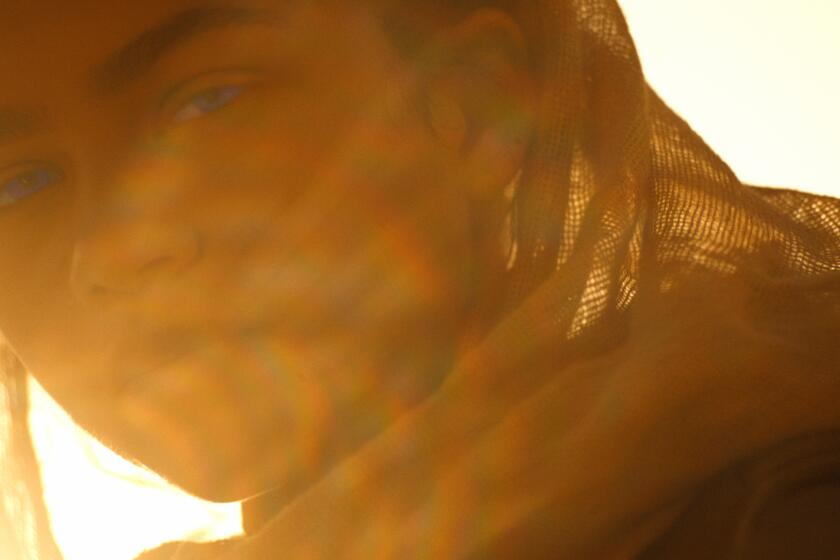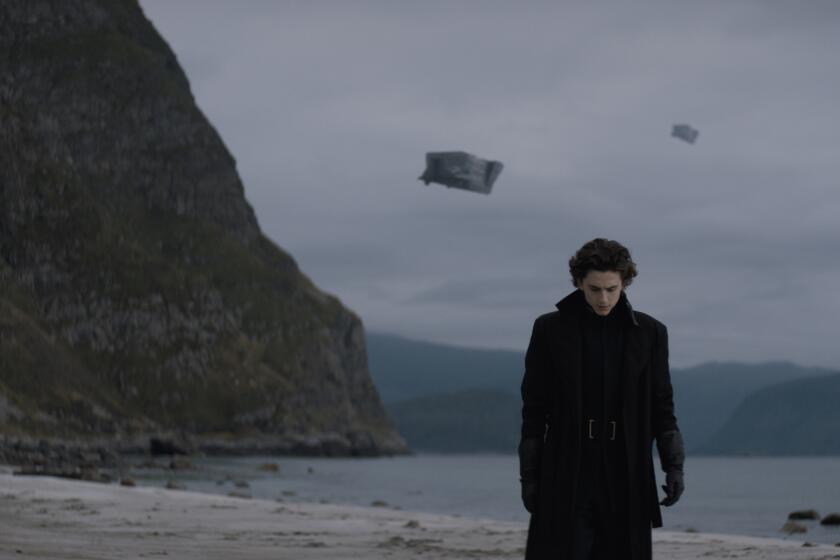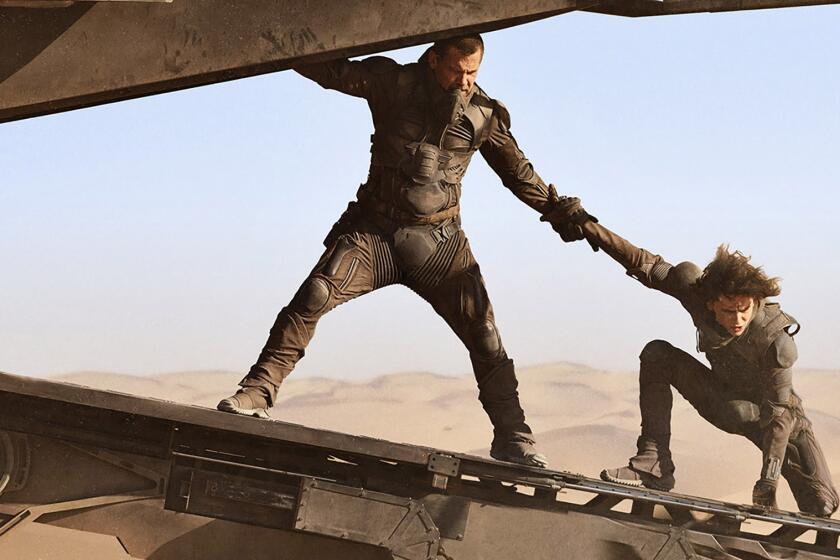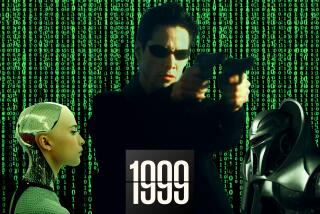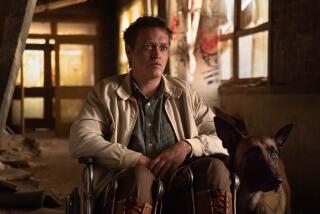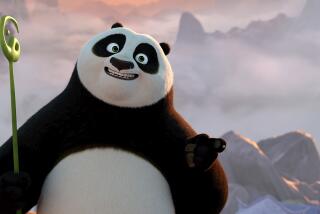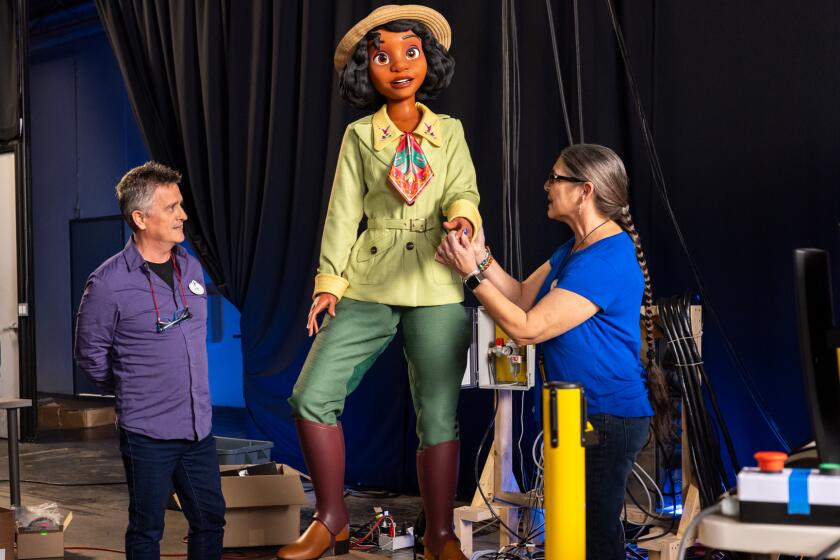How the ‘Dune’ team brought the villainous Harkonnen to life
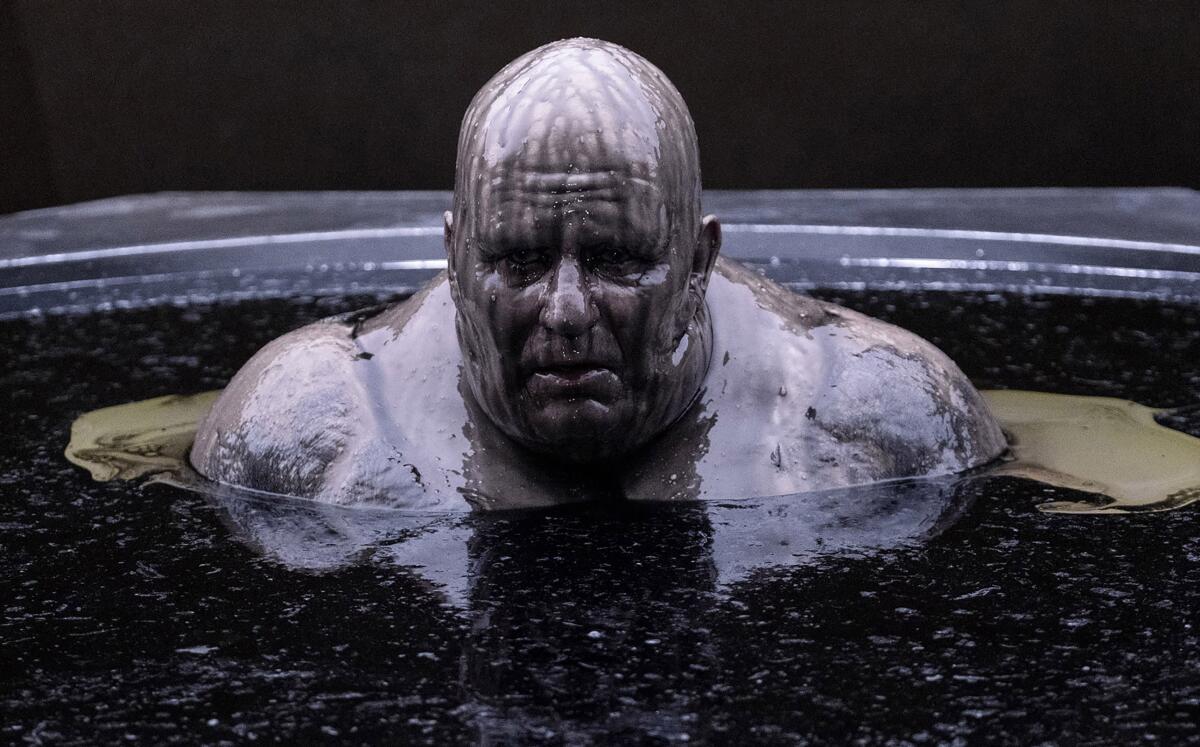
Well before Darth Vader was even a gleam in George Lucas’ eye, author Frank Herbert knew that any good sci-fi epic needs a formidable villain. In his sweeping 1965 novel “Dune,” Herbert introduced one for the ages: a corpulent, power-hungry sadist with the suitably sinister name of Baron Vladimir Harkonnen.
Translating Herbert’s seminal book to the screen in the highly anticipated new film “Dune,” now in theaters and streaming on HBO Max, director Denis Villeneuve knew it was critically important to get the Baron and his villainous Harkonnen empire right. More than anything, he wanted to capture the experience he had when he first immersed himself in the complex world of Dune, with all its mystery and menace, as an impressionable 13-year-old in Quebec, Canada.
“The movies that I loved when I was that age were talking to me as if I was an adult,” Villeneuve says. “They were not afraid to be dark and tragic.”
As conceived by Herbert, the Harkonnens, under the ruthless rule of the Baron, are the cruel overlords of the desert planet Arrakis, exploiting it for its precious natural resource known as “spice” and oppressing its native people, the Fremen. A man of insatiable appetites and sadistic tendencies, the Baron is so obese he requires an antigravity “suspensor suit” to move. From his castle on the Harkonnens’ home planet of Giedi Prime, he commands an army that follows him with slavish devotion.
The new film “Dune” ends on a cliffhanger. With the second half of Frank Herbert’s classic story still to tell — not to mention all its sequels and prequels — where will the “Dune” universe go from here?
For all its detailed world-building, however, much in Herbert’s novel is left to the imagination — just one of many major challenges posed to those trying to adapt it — and previous efforts to bring the book to the screen envisioned the Harkonnens in different ways.
In his doomed effort to tackle the book in the 1970s, director Alejandro Jodorowsky hoped to cast Orson Welles as the Baron and recruited Swiss artist H.R. Giger, who would go on to worldwide renown for his work on “Alien,” to design the Harkonnen castle. Director David Lynch’s ill-fated 1984 “Dune” depicted the Baron as a grotesque, lascivious loudmouth covered in hideous pustules, with a codpiece-wearing Sting as his heir apparent Feyd-Rautha.
Casting Stellan Skarsgård as the Baron, Dave Bautista as his malevolent nephew Rabban, dubbed “the Beast,” and David Dastmalchian as the cunning “Mentat” advisor Piter de Vries, Villeneuve and his team set out to create a bold new vision of the Harkonnen world.

Reconceiving the Harkonnens
For Villeneuve, it all started with the Baron — and there, as he saw it, Herbert’s book was something of a mixed bag.
“I think the book is more relevant than ever but some of the elements have aged a bit, and I felt that the Baron was sometimes a bit like a mustache-twisting caricature,” he says. “In the book, he is very talkative but in the film I wanted him to be a man of few words. I wanted the Baron to be frightening, to be a threat, to be a very intelligent being, not a fool or a caricature.”
In Herbert’s novel, it is implied that the Baron is a sexual predator with a preference for young boys, a trait that was highlighted in Lynch’s film. Villeneuve and his co-writers, Jon Spaihts and Eric Roth, jettisoned that aspect of the character entirely. “I felt this idea was a bit clichéd and didn’t age well,” Villeneuve says. “It didn’t interest me.”
“Dune” director Denis Villeneuve discusses several significant departures from the sci-fi classic source material.
Villeneuve and storyboard artist Sam Hudecki spent weeks brainstorming approaches to the Baron’s physicality, trying to convey a sense of muscularity along with corpulence. “I was trying to bring him closer to the spirit of a gorilla than a fat baby,” Villeneuve says. “I wanted to get away from a feeling of decadence and more toward a feeling of power.”
Lynch’s film, which was widely panned and ultimately disowned by Lynch himself, invested the Harkonnens with a slightly cartoonish, steampunk-inflected aesthetic. By contrast, Villeneuve envisioned the Harkonnens’ Giedi Prime as a highly advanced but colorless world, devoid of any semblance of vegetation or natural light, to the point that its inhabitants have evolved to become ghostly pale and hairless.
“I came in with this idea that they will be probably the most evolved beings in this world, the richest and most sophisticated, and that their technology will be disconnected from nature,” Villeneuve says. “I’m in love with the color black and I’ve been dreaming for decades about creating a world made out of one color with a lot of sensuality and high design.”
Designing the Harkonnens’ home world
Production designer Patrice Vermette took Villeneuve’s conception of the Harkonnen world as a nightmare of industrialization run amok and extended that to every aspect of the visual environment.
“It’s a world that has overexploited its natural resources, like a sponge that has been squeezed and squeezed,” says Vermette, who drew inspiration from over-industrialized areas of countries like China, America and Brazil. “You take our reality on Earth and then you reinterpret that into the world of Dune.”
For the Harkonnen palace, rather than rely on extensive CGI, a vast physical set was built on a soundstage in Budapest. “We all shared the same philosophy on the film that the more immersive we can make the space, the better,” Vermette says.
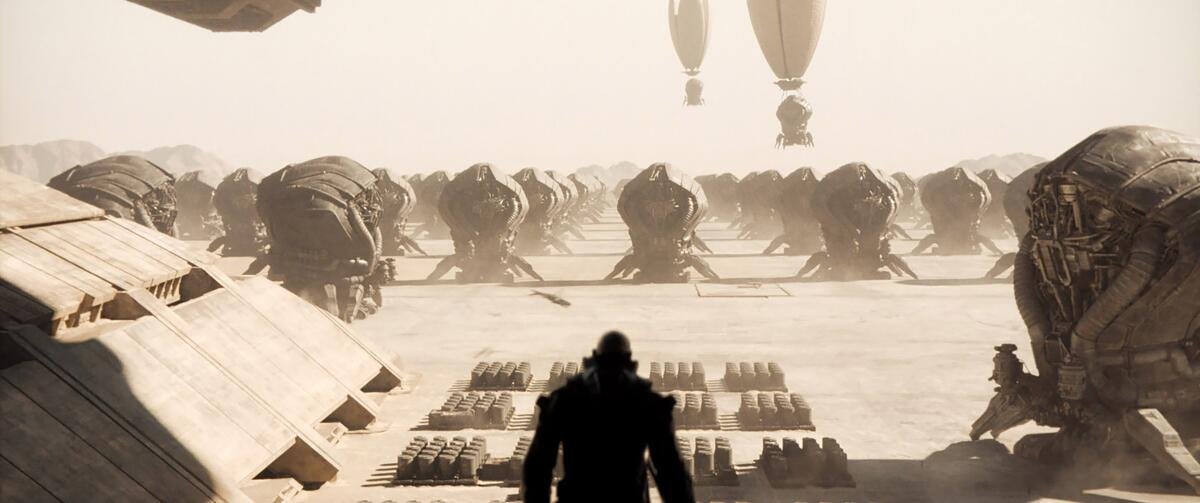
”The sets were humongous and everything was physically built,” says Skarsgård. “You get on set that first day and you see this huge room that is your home and you know that room will do a lot of the work for you.”
The same grounded, less-is-more approach to visual effects was applied to the Baron’s floating suspensor suit. “For a couple of those shots, we actually used a technique where Stellan sat on one end of a seesaw-like cantilever,” says visual effects supervisor Paul Lambert. “He was strapped in under his robes and there were a bunch of crew behind him and they just seesawed him.”
Exterior shots of the Harkonnen palace and of Giedi Prime as seen from space were created digitally. “We tried to convey that the planet is just one big city,” says Lambert. “There is no nature. It’s like when you see images of Earth with L.A. or New York as these clusters of lights — the whole planet is like that basically.”
Heralded as the best sci-fi novel of all time, previous adaptations of Frank Herbert’s ‘Dune’ have fizzled. Now it’s Denis Villeneuve’s turn.
Dressing the Harkonnens
From the outset, Villeneuve and costume designer Jacqueline West wanted to present the Harkonnens with an insect-like appearance. “I love insects and I wanted the Harkonnens’ design to be very insectoid,” says Villeneuve. “They are invaders and colonizers, so we really focused on this idea that they are like predators.”
“Insects have textures so I used a lot of molded black leather with insect designs carved into the leather,” says West. “The references were from scorpions, spiders and ants. Both the Baron and Rabban have this almost ant-head-like helmet.”

For the character of Piter de Vries, West was inspired by another type of bug. “I made him a black praying mantis,” she says. “He’s very long and lean and stick-like.” (The character of Feyd-Rautha does not appear in Villeneuve’s film so there was no question of resurrecting the much-maligned codpiece.)
To heighten the Baron’s vampiric quality, West dressed Skarsgård in a flowing black robe. “I wanted the Baron to be very gentle in his movement and almost feminine,” says Skarsgård. “That costume is one of the best I’ve ever had.”
While the wardrobe of the Harkonnens is otherwise entirely black, the slaves who serve the Baron are outfitted in lighter-hued garb. “The young slave girls are in a kind of flesh-toned, almost medical-looking white rubber smock,” says West. “That gives the contrast of innocence and evil.”
Alejandro Jodorowsky’s ambitious adaptation of Frank Herbert’s ‘Dune’ fell apart. ‘Jodorowsky’s Dune’ explores the project’s lasting influence.
Playing the Baron
Skarsgård had never read Herbert’s book before Villeneuve approached him about playing the Baron. But while he was initially surprised at how relatively few lines the Baron had in the screenplay, he was drawn to the idea of creating a character whose power comes less from his dialogue than from his sheer physical presence.
“I was very happy that the Baron didn’t talk a lot because usually that is more efficient and frightening,” says Skarsgård, who interpreted the character’s psychology in Machiavellian terms. “There was no analyzing his background. Why is he so mean? Who was mean to him when he was a kid? All of that is pointless. I just thought it would be fantastic to be allowed to do something like a monster that still is a human.”
Actually inhabiting that monstrous form, though, proved a daunting challenge for the 70-year-old Swedish actor, who had to be fitted with 80 pounds of prosthetics and makeup each day. “Getting into that suit took eight hours and then it took two hours to get out of it,” says Skarsgård. “It’s like a kind of very refined Chinese torture. I regretted taking the role a couple of times.”
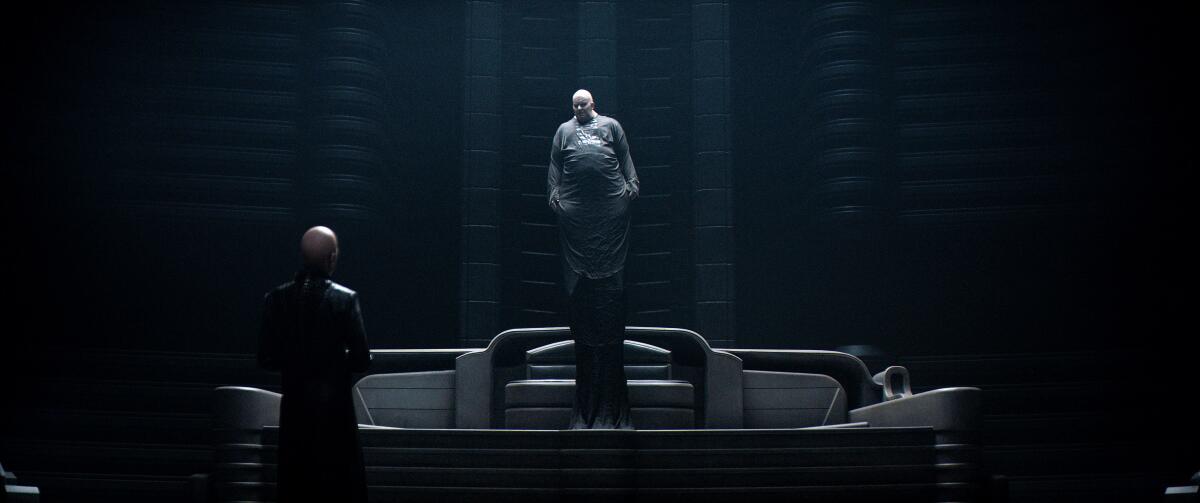
In one of the most visually striking sequences in the film, the Baron emerges naked from a black, viscous bath and rubs his oily hand over his pale, bald head. For Villeneuve, the shot served as a nod to another inspiration for the character: Marlon Brandon’s Colonel Kurtz in Francis Ford Coppola’s “Apocalypse Now.” “When Stellan was in the bath, I specifically asked him to do this in order to pay homage to one of my favorite characters of all time,” the director says. “There are several winks to masters that I love — Ridley Scott, Steven Spielberg, David Lean — because I just wanted to have fun.”
For Skarsgård, though, who had to be held beneath the oily liquid to keep his prosthetic suit from floating upward, it was less fun than it was another moment of deep discomfort. “Coming up out of that bath with all that black s— coming out of your mouth and your eyes and everywhere, it’s very hard to maintain any form of dignity,” he says.
While Villeneuve promises that the Harkonnens will play an even more prominent role in the planned sequel, a weary Skarsgård has a simple request for the filmmaker. “Check with me first,” he says, laughing.
Timothée Chalamet, Zendaya and Oscar Isaac headline Denis Villeneuve’s seat-rattling adaptation of the Frank Herbert sci-fi classic.
More to Read
Only good movies
Get the Indie Focus newsletter, Mark Olsen's weekly guide to the world of cinema.
You may occasionally receive promotional content from the Los Angeles Times.
